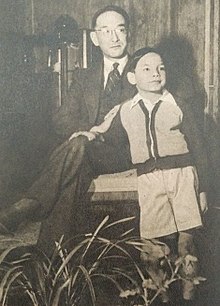Satosi Watanabe
This article needs additional citations for verification. (May 2008) |
Satosi Watanabe | |
|---|---|
 Watanabe and his son, May 1949 | |
| Born | May 26, 1910 |
| Died | October 15, 1993 (aged 83) Tokyo |
| Other names | 渡辺 慧 |
| Scientific career | |
| Fields | Theoretical physics |
Satosi Watanabe (渡辺 慧, Watanabe Satosi, 26 May 1910 – 15 October 1993) was a
Early life and education
Satosi Watanabe was born on May 26, 1910, in Tokyo. He attended Gakushuuin Middle High School and Tokyo High School. In 1933, he graduated from Tokyo Imperial University in theoretical physics, where Torahiko Terada was his teacher.
The imperial government sent him to France to study. Louis de Broglie encouraged Watanabe to study thermodynamics and wave mechanics.
In 1937, he moved to Leipzig and started to study nuclear theory under Heisenberg. In the same year, Watanabe married Dorothea Dauer, a scholar of German literature.
In 1939, at the beginning of World War II, he left Germany and stayed with Niels Bohr for a time. In December, he returned to Japan with his family.
Career
In Japan, he worked at the Physical and Chemical Research Institute (Rikagaku Kenkyujo) at Tokyo Imperial University as an assistant professor, and as a physics professor at Rikkyo University. In 1950, he left for the United States.
His argument that quantum mechanics is time-asymmetric (irreversible; non-invariant under the time reversal transformation) is repeated in a number of his papers (1955; 1965; 1966; 1972). This result means that physicists have used the wrong transformation of probability laws to represent time reversal, and the claims that quantum mechanics is time reversal invariant are invalid. Watanabe's argument has not been accepted by physicists or philosophers however. The assumption that quantum mechanics is time symmetric on the basis of conventional proofs is almost universal in the literature on time in physics to this day.
He developed the Double Inferential Vector Formalism (DIVF),
Time-symmetric interpretations of quantum mechanics were first suggested by
In 1956, he became a researcher at the IBM Watson Laboratory and started to build his own information theory based on quantum mechanics. He taught at Yale University and the University of Hawaii, became chairman of the International Time Academy, and was the Vice President of International Philosophy Academy.
On October 15, 1993, he died in Tokyo.
Family
His father, Chifuyu Watanabe, was a Minister of Justice at Second Wakatsuki Cabinet. His elder brother, Takeshi Watanabe, was Vice Minister of Finance for International Affairs and director general of Asia Development Bank. His wife, Dorothea Dauer Watanabe, was a professor of German (language and literature) at the University of Hawaii. His son, Hajime Watanabe, is a professor of philosophy at the University of California, Santa Barbara.
See also
References
- ^ Watanabe, Satosi (1969). Knowing and Guessing: A Quantitative Study of Inference and Information (page scan). New York: Wiley. pp. 376–377.[dead link]
- OCLC 522269.
- ^ Watanabe, Satosi. "Symmetry of physical laws. Part III. Prediction and retrodiction." Reviews of Modern Physics 27.2 (1955): 179.
- S2CID 22228793.
- S2CID 26246226.
- ISBN 978-0792344537, pp. 1–8, p. 2
Bibliography
- Le deuxième théorème de la thermodynamique et la mécanique ondulatoire, Paris : Herman et Cie, 1935
- Knowing and guessing : a quantitative study of inference and information, New York : John Wiley & Sons, 1969 ISBN 0-471-92130-0
- Pattern recognition : human and mechanical, New York : John Wiley & Sons, 1985 ISBN 0-471-80815-6
